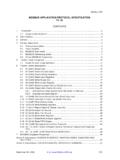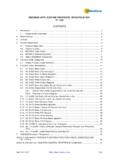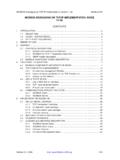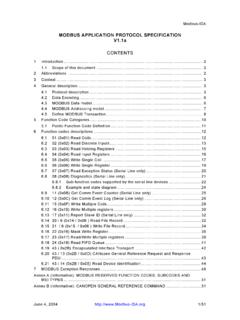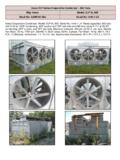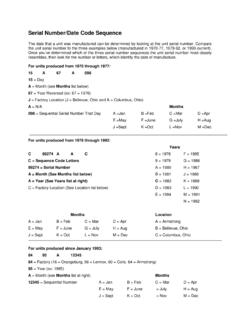Transcription of Specification and Implementation Guide for …
1 MODBUS over serial line Specification and Implementation Guide 20, 2006 MODBUS over serial Line Specification and Implementation Guide MODBUS over serial line Specification and Implementation Guide 20, 2006 Contents 1 Introduction .. 4 Scope of this document .. 4 Protocol 5 Conventions .. 5 Compliance .. 6 Glossary .. 6 2 MODBUS Data Link Layer .. 7 MODBUS Master / Slaves protocol 7 MODBUS Addressing 8 MODBUS frame 8 Master / Slaves State 9 The two serial Transmission 12 Error Checking Methods.
2 19 3 Physical 20 20 Data Signaling Rates .. 20 Electrical 21 Multipoint System 27 Mechanical Interfaces .. 29 Cables .. 32 Visual Diagnosis .. 32 4 Installation and Documentation .. 33 33 User Guide .. 33 5 Implementation Classes .. 34 6 Appendix .. 35 Appendix A - Management of serial Line Diagnostic Counters 35 Appendix B - LRC/CRC Generation .. 38 Appendix E - References .. 44 MODBUS over serial line Specification and Implementation Guide 20, 2006 Document modifications Month-Year Modifications Nov 02 Creation.
3 This document comprises a description of Master / slave protocol and of the two different transmission modes ( RTU, ASCII). The main features of the physical layer ( RS485, RS232) and some recommendations are provided. Implementation classes are proposed to Guide the Implementation . Aug 30, 2006 Minor clarifications and correction of Dec 20, 2006 Minor clarifications and correction of over serial line Specification and Implementation Guide 20, 2006 1 Introduction Scope of this document The MODBUS standard defines an application layer messaging protocol, positioned at level 7 of the OSI model that provides "client/server" communications between devices connected on different types of buses or networks.
4 It standardizes also a specific protocol on serial line to exchange MODBUS request between a master and one or several slaves. The objective of this document is to present the MODBUS protocol over serial line, in order to be used by all system designers when they want to implement MODBUS protocol on their serial line products. Thus, this document will facilitate interoperability between devices using the MODBUS protocol. This document comes in complement to the document called "MODBUS Application Protocol Specification ". In chapter 5 different Implementation classes are defined for "MODBUS serial Line".
5 Specification of a class is the sum of requirements that a device must respect in order to belong to that class. Figure 1: General overview of MODBUS documents MODBUS Application Protocol Specification The MODBUS application protocol ( OSI Level 7) MODBUS over serial Line Specification & Implementation Guide serial Line Specification (OSI Levels 1 & 2) This document MODBUS over serial line Specification and Implementation Guide 20, 2006 Protocol overview This document describes the MODBUS over serial Line protocol. MODBUS serial Line protocol is a Master-Slave protocol. This protocol takes place at level 2 of the OSI model.
6 A master-slave type system has one node (the master node) that issues explicit commands to one of the "slave" nodes and processes responses. Slave nodes will not typically transmit data without a request from the master node, and do not communicate with other slaves. At the physical level, MODBUS over serial Line systems may use different physical interfaces (RS485, RS232). TIA/EIA-485 (RS485) Two-Wire interface is the most common. As an add-on option, RS485 Four-Wire interface may also be implemented. A TIA/EIA-232-E (RS232) serial interface may also be used as an interface, when only short point to point communication is required.
7 (see chapter "Physical Layer") The following figure gives a general representation of MODBUS serial communication stack compared to the 7 layers of the OSI model. Layer ISO/OSI Model 7 Application MODBUS Application Protocol 6 Presentation Empty 5 Session Empty 4 Transport Empty 3 Network Empty 2 Data Link MODBUS serial Line Protocol 1 Physical EIA/TIA-485 (or EIA/TIA-232) Figure 2: MODBUS Protocols and ISO/OSI Model MODBUS application layer messaging protocol, positioned at level 7 of the OSI model, provides client/server communication between devices connected on buses or networks.
8 On MODBUS serial line the client role is provided by the Master of the serial bus and the Slaves nodes act as servers. Conventions In this document, the following words are used to define the significance of each particular requirement. "MUST" / "REQUIRED" All requirements containing the word "MUST" are mandatory. The word MUST, or the adjective "REQUIRED", means that the item is an absolute requirement of the Implementation . These words are underlined. "SHOULD" / "RECOMMENDED" All recommendations containing the word "SHOULD", or the adjective RECOMMENDED , are considered desired behavior.
9 These recommendations should be used as a guideline when choosing between different options to implement functionality. There may be valid reasons in particular circumstances to ignore this item, but the full implications should be understood and the case carefully weighed before choosing a different course. These words are underlined. "MAY" / "OPTIONAL" The word MAY , or the adjective "OPTIONAL", means that this item is truly optional. One designer may choose to include the item because a particular marketplace requires it or because it enhances the product, for example; another designer may omit the same item.
10 EIA/TIA-485(or EIA/TIA-232)MODBUS Master / SlaveMODBUS Application Layer Client / server MODBUS over serial line Specification and Implementation Guide 20, 2006 Compliance An Implementation is not in conformity if it fails to satisfy one or more of the MUST requirements from its Implementation class. An Implementation that satisfies all the MUST requirements and all the SHOULD recommendations is said to be "unconditionally compliant". One that satisfies all the MUST requirements but not all the SHOULD recommendations is said to be "conditionally compliant". Glossary Definition of particular words, symbols, and abbreviations used in this document.

